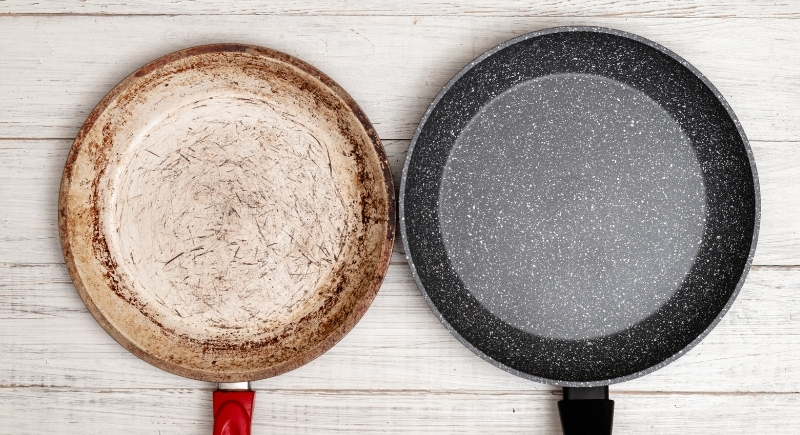So This Is Why Non-Stick Pans Never Seem to Last
Non-stick pans promise easy cooking and quick cleanups, but anyone who’s owned one knows the honeymoon doesn’t last. You start off flipping perfect pancakes and sliding eggs around like a pro, then one day your omelet clings to the pan. The truth is, non-stick cookware just isn’t built for the long haul. Most pans only last two to five years, and many don’t even make it past their second birthday.
Both Teflon (PTFE) and ceramic-coated pans share the same fate. They start strong, but over time, high heat, rough utensils, and harsh scrubbing wear down the coating. This results in scratches, chips, and a sticky surface that defeats the purpose of “non-stick.” Even high-end ones like Calphalon or Le Creuset give out after a few years. You can treat them with care, but eventually, the coating breaks down, and food begins to cling again.
Why They Break Down So Fast

Image via Canva/konstiantynzapylaie
The problem isn’t entirely with you. Non-stick coatings are fragile by design. Overheating can bake oils onto the surface and leave behind a sticky residue that’s impossible to clean without damaging the pan further. Using non-stick sprays makes things worse since they contain additives that cling to the coating. Once that happens, your pan’s smooth glide is gone for good.
Even the so-called “good guy” brands have limits. Caraway pans show discoloration and scratches after a year of use. GreenPan’s ceramic coating is thicker and more durable, but the company isn’t transparent about its materials. The Always Pan loses its slick surface within months for many users. The average home cook ends up replacing non-stick cookware often, which contributes to waste and makes it one of the least sustainable kitchen tools.
What Manufacturers Don’t Tell You
Pan makers love to say their products are “built to last,” but the fine print usually tells a different story. Many non-stick pans come with a lifetime warranty for the metal body but only a one-year warranty for the coating. Translation: once that slick surface starts to go, you’re on your own.
A Calphalon representative once claimed their pans could last for “many years” with proper care. But when pressed for real numbers, a store clerk admitted that three to four years is typical, and five years is exceptional. Even Calphalon’s newer Unison pans, which use a bonded non-stick process, begin showing wear after about a year. The marketing message may sound reassuring, but most manufacturers acknowledge privately that the lifespan is limited.
How to Make the Relationship Last

Image via Getty Images/crispphotography
All isn’t lost if you handle your pans gently. Stick to low or medium heat, use wooden or silicone utensils, and skip the cooking sprays. Hand wash them with mild soap and avoid stacking them without protection. Store them with a trivet or cloth between layers to prevent scratches.
If you follow those rules, you might stretch your pan’s life closer to five years. Some newer models like Made In’s CeramiClad Frying Pan show promise thanks to their 5-ply construction and PTFE coating. Other long-lasting options include GreenPan’s 5-ply stainless steel ceramic line, which performs well even after surface wear.
Accepting the Reality
Maybe it’s time to stop expecting non-stick pans to behave like heirlooms. Stainless steel, carbon steel, and cast iron can last for decades when cared for properly. Non-stick cookware, on the other hand, offers short-term comfort with an expiration date. Once the coating fades, it’s best to let go and move on.